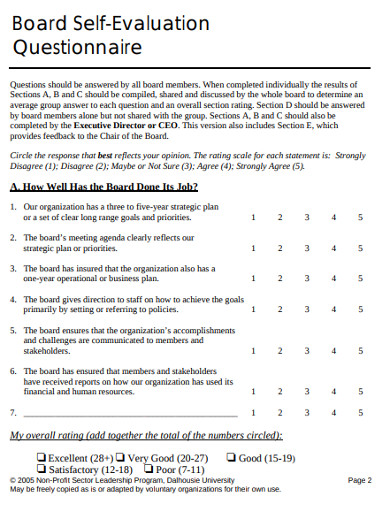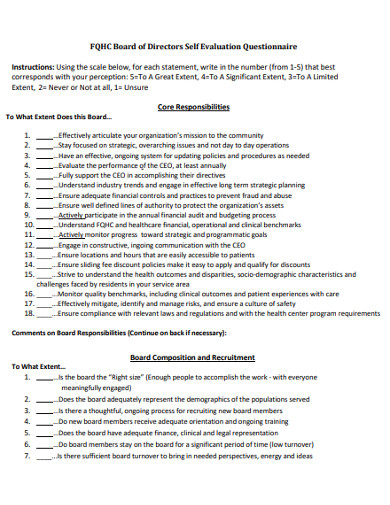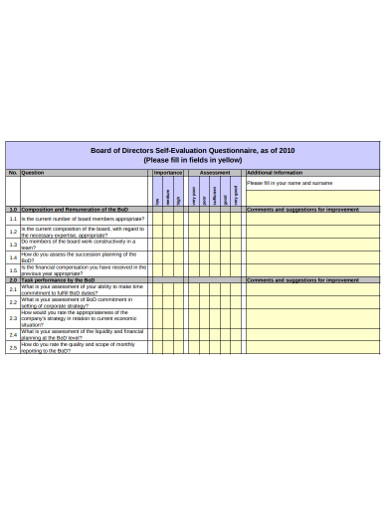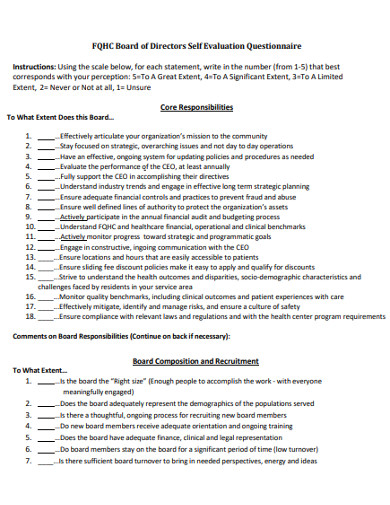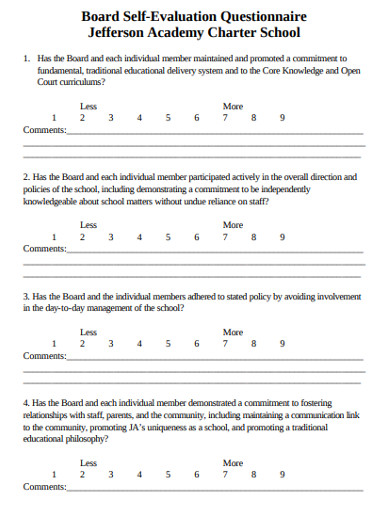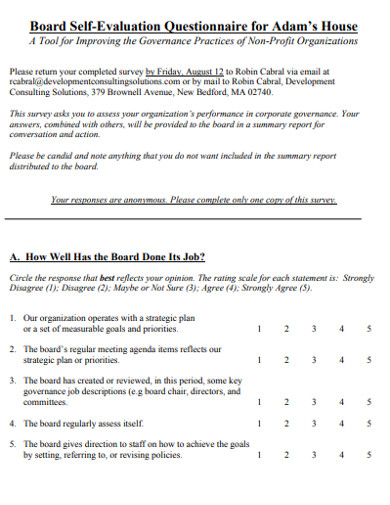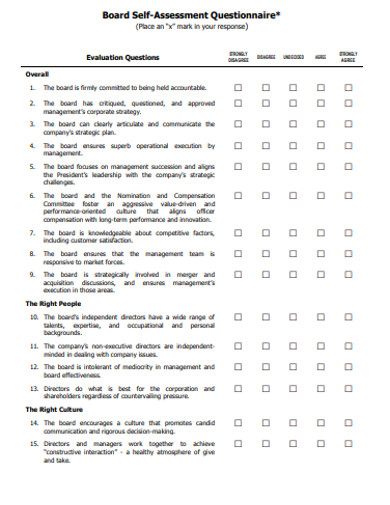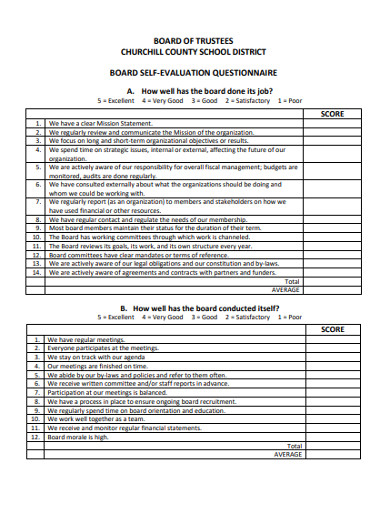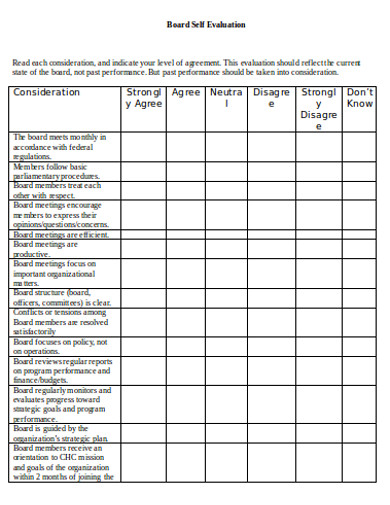9+ Board Self-Evaluation Questionnaire Examples to Download
Imagine a drop of liquid falling into a glass of water. Whatever the nature of the liquid, it spreads across the water in the vessel. Like the drop of liquid, board members are a small circle of individuals whose actions and decisions will have a ripple effect across the organization. Each person should uphold the institution’s interest at heart when it comes to crossroads. Only by putting the organization before one’s self can the board member act for the good of all the members and stakeholders. Because the board members are in the driver’s seat of the company, they should conduct self-evaluation sessions to recalibrate their priorities.
Board self-evaluation is a reflective activity for the individuals within the circle. It reminds the board members of their duties and functions and assesses their performance after a specified period. With the help of questionnaires, a self-assessment session points out rooms for improvement in the exercise of the individual’s obligations to the company. Members of the board can make sure that their interests are in line with the organization’s objectives. For this to be possible, the board self-evaluation questionnaires have to contain the expected roles and responsibilities of each member, and the criteria for the group’s synergy. The results of the assessment will be useful in crafting plans and strategies for the company moving forward.
Performance evaluation shouldn’t be seen in the negative light as it isn’t conducted to cast doubts on someone’s capacity. The company’s management conducts employee evaluation, even when they have hired and trained the best people in the industry. The management sees it fit that it routinely reviews and recalibrate the employee’s priorities and functions. Evaluation forms and reports help the company see where its members can improve and recognize when there are accomplishments. The results of the assessment will refine the processes that worked and reconfigure strategies that didn’t work out. For these reasons, the board, which exercises the leadership and administrative functions of the company, should also self-evaluate.
Gathering of the Masters of One
Being a jack of all trades helps in managing a multi-disciplinary system, but when you’re a member of a governing board, you must be proficient in at least one of those disciplines. The members of the board, on their own, are qualified to sit in the table. They have a good background with the board agenda on how to keep the company up and running. In general, the circle should be made up of diverse but equitably learned individuals. This diversity makes for a check-and-balance structure on the board. When members understand each and the other’s roles, they can set realistic expectations and objectives, too.
While they are capable on their own, the organization board members must work as a group. They represent the entire company, its goals, and what it stands for. Therefore, their group dynamic is as important as their functions. Overstepping on one’s limits or underperforming your job description will strain the interaction. The circle should be open to differences in opinion, and constructively address issues that will come up. The synergy and relationship between the members influence the board’s effectiveness. Tension within the highest circle of the company can escalate and reverberate down to the ground floor. Therefore, group dynamics should be a criterion for assessment.
A Different Kind of Corporate Altruism
The board is responsible for the welfare of the company. And the company’s well-being lies on a lot of things. Legally known as fiduciary duty, the board looks out for the interest of the members, clients, shareholders of the company, and the organization as a whole before the board members consider their personal agenda. These people make, evaluate, and oversee crucial business decisions for the benefit of the company. Suffice it to say, there is an enormous weight on the shoulders of the board. Routine self-evaluations and recalibrations help keep the circle competent and efficient in deciding for the good of the company and its members.
9+ Board Self-Evaluation Questionnaire Examples & Templates
The following are examples of board self-evaluation questionnaires that can be adopted for use.
1. Sample Board Self-Evaluation Questionnaire Example
2. Board of Directors Self-Assessment Evaluation Questionnaire
3. Basic Board of Directors Self Evaluation Questionnaire Example
4. Simple Board of Self-Evaluation Questionnaire Example
5. Standard Board of Self Evaluation Questionnaire Example
6. School Board Self-Evaluation Questionnaire Example
7. Board Self-Evaluation Questionnaire for House Example
8. Formal Board Self-Evaluation Questionnaire Example
9. District Board Self-Evaluation Questionnaire Example
10. Board Self Evaluation Questionnaire in DOC
Administering Board Self-Evaluations
The questionnaires you would use should give you the results you need. It should completely measure the efficiency of the board members to safeguard company interest. What should be the key criteria for assessing the efficiency of the board in fulfilling its duties and obligations?
1. Capacity to Take the Helm
Being the highest circle that steers the company towards a determined direction, the board members show adeptness in leading and managing the business and the organization. Each member and the group as a whole actively exhibit instances of such skill during the term in office. The board is making significant strides to push for the growth and development of the company. The group is also an effective representative of what the organization envisions itself.
2. Productive Board Meetings
Whenever there is a meeting, the board can arrive at a resolution after. The duration of the sessions is maximized so that there is less issue pending decision. The meeting has an organized discussion so that an issue is thoroughly tackled before moving on to another. The floor is open to ideas and constructive criticisms of such. The board is well-informed of the current situation of the company and its members. It considers these issues in the discussion for answers.
3. Active and Responsive Synergy
The interaction within the circle is professional. Members set aside creative differences in favor of arriving at the most sound decisions and board resolution. The floor has an active exchange of honest ideas. Each person can state his or her opinion and suggestion without fear of consequences for the dissent. The group dynamic displays trust and confidence in one’s self and the capacity of others in the circle.
4. Individual Input and Output
The board is composed of people who are knowledgeable in their fields. The variety of disciplines contributes to the success of the organization. Therefore, the input of each member is critical in every decision. And the members exercise this function religiously during discussions. The circle values the rich exchange of ideas and active engagement.
Adding drop after drop will fill the glass eventually. That is why it shouldn’t be the only goal. Will the additional drop preserve the integrity of the water inside? If change is introduced into the system, will it be a beneficial break from tradition? The repercussions of the decision made in that small circle will not be contained within that exclusive round table.



